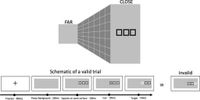In a groundbreaking study on visual perception, researchers have uncovered a fascinating phenomenon known as the “close advantage effect” (CAE), which reveals that our visual system processes objects perceived as closer to us more quickly and accurately than those that are farther away. This study, conducted by a team of scientists from York University and led by T. Ahsan, L. M. Wilcox, and E. Freud, utilized a series of experiments to delve into how perceived depth affects our allocation of attention, ultimately yielding insights that could resonate in fields ranging from psychology to robotics.
The research, published in Scientific Reports, involves a series of experiments utilizing different methodologies, including the Posner cueing task and the Egly-Driver task. In the first experiment, dubbed Experiment 1a, scientists employed a Posner cueing task with 27 participants (average age 25.3 years) to measure their accuracy in identifying targets on close versus far surfaces. The results demonstrated a significant “close advantage effect”, where accuracy was markedly higher for targets situated on the close surface compared to those on the far surface.
Specifically, the study reported a main effect of perceived depth with respect to accuracy, with results showing F(1, 26) = 4.93, p = 0.035, indicating that responses to close surface targets were quicker and more accurate than those perceived as farther away. Furthermore, the researchers observed a reduction in the Posner effect in close surfaces, suggesting that attentional resources are more efficiently allocated in this space.
Experiment 1a was further validated in a subsequent study (Experiment 1b) where researchers manipulated the shape of the stimuli to rule out the influence of surface size on accuracy. Despite varying the surface conditions, the key findings of attentional allocation due to depth perception remained consistent.
In subsequent experiments (2a and 2b), the researchers made significant strides in understanding attention shifts between surfaces by executing the Egly-Driver task with 24 and 26 participants, respectively. Results revealed a marked enhancement in accuracy when participants shifted their attention from far surfaces to close ones, reinforcing the critical idea that perceived proximity facilitates more efficient attentional shifts. Statistical analyses revealed a main effect of perceived depth (F(1, 23) = 6.57, p = 0.017) and cue validity (F(1, 23) = 38.07, p < 0.001).
The continuing theme across the experiments highlights that individuals are not only more accurate when perceiving targets in close proximity, but also less vulnerable to invalid cues when targets are situated closer. The research indicates that closer objects are given preferential processing due to their immediate relevance to our actions or interactions.
Importantly, the research does not merely rehash existing theories; it offers new interpretations about how depth perception influences cognitive processes, specifically attention. The authors argued that this could be linked to the concept of action candidacy, where objects in closer spatial fields require faster cognitive processing due to their higher likelihood of interaction.
The implications of this research extend far beyond academic interest. It could influence various practical applications from designing better assistive technologies to enhancing user interfaces in virtual environments. Moreover, insights from the study could inform practices in fields such as robotics and artificial intelligence, where understanding human attentional mechanisms could enhance interaction designs.
The researchers emphasize the need for further exploration, particularly in varying depth cues that might influence perception and attention. This exploration could provide deeper insight into how our visual system operates, offering avenues for future investigations into not only cognitive science but also advancements in technology that mimic or enhance human visual processing capabilities.
In conclusion, the series of experiments not only validate the powerful influence perceived depth has on attention allocation but also underscore the complexity of our perceptual systems. This work opens the door for continued research into the cognitive processes that enable us to navigate our 3D world effectively.

